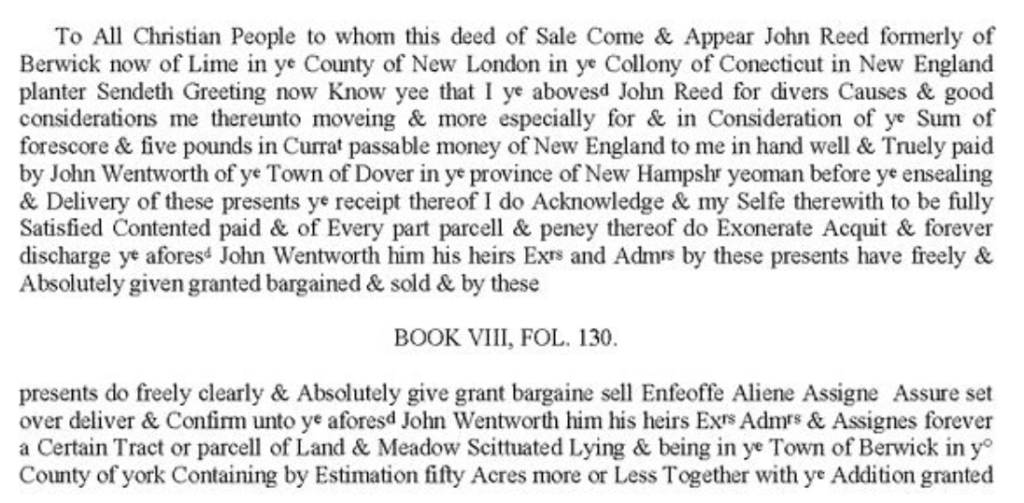| Battle: | Battle of Dunbar in Dunbar, East Lothian, Scotland |
| Ship/Arrival: | Unity, Dec 1650 |
| Prisoner and List: | |
| Name Variations: | |
| Residences: | |
| Other SPOW Associations: |
Published: 02 Sep 2018
Updated: 27 Mar 2020
Researchers: Dr. Andrew Millard, Teresa Rust
Editor: Teresa Rust
IMPORTANT UPDATE! (July 2018)
According to, Christopher Gerrard, Pam Graves, Andrew Millard, Richard Annis, and Anwen Caffell, Lost Lives, New Voices: Unlocking the Stories of the Scottish Soldiers at the Battle of Dunbar 1650, (England: Oxbow Books, 2018), on page 251, John is categorized as: Probable [that he is a Dunbar prisoner transported on the Unity] Reed, John. Residences: Wells, Berwick ME, Lime CT. Appears: 1661. D. bef. 1713. Countryman to Micum McIntire, and lived on his land. [Exiles; DR] For explanations of the category, abbreviations and references see List of Dunbar prisoners from Lost Lives, New Voices.
First Generation in the New World
1. JOHN¹ REED, was born, presumably in Scotland, and died before 1713, possibly at Salmon Falls on March 18, 1689/90.
Biographical Notes:
1. Mary Reade and John Read are mentioned in a will in York County, Maine on 23 Oct 1663. “I give unto Mary Reade my…” and “I desire … & John Read the overseers of this my last will…”1
2. Jonathan Tucker shared, “There is a notation on that page that John Reed, a Probable Dunbar prisoner, was “Countryman to Micum McIntire, and lived on his land.” The land in question was a land grant obtained by Micum on December 11, 1662 (his first) at the northern, frontier end of the settlement of Salmon Falls (Newichawannock), between the river and the main north-south road (now Route 236). Micum never lived on the property, but he allowed John Reed to live there. ”Above Salmon Falls in 1662 lived John Key, James Barry, John Reed, and another James Grant. Alexander Cooper, called “Sander Copper” in Court records was settled in upper Kittery in 1662. Micum McIntyre had a grant here the same year, on which John Reed lived.”“The First Permanent Settlement in Maine,” Everett S. Stackpole Excerpt from Sprague’s Journal of Maine History, Vol. XIV, No. 4 (Prepared for the meeting of the Piscataqua Pioneers at South Berwick, August 18, 1926.) Re-Published by The Old Berwick Historical Society, May, 1968 After Micum’s death in 1705, the property was inherited by Daniel Mcintire, Micum’s middle son. Finally, the references to John Reed being in Lyme, CT later in his life are probably inaccurate. The most prominent and readily identifiable John Reed living in Lyme at that time was of Puritan English ancestry, and second or third generation in the colony. I hope that’s useful. ~Jonathan Tucker:
2. Gregg Purinton at : “I recently started researching John Reed. He was killed by Indians in Salmon Falls on March 18, 1689/90. His wife Mary and son John were taken to Canada. Mary was returned shortly and died in Braintree, MA in 1691. His son John was not released until 1695. That son appears in “York Deeds” Book 12 folio 337, where he sells the 50 acres of land granted to his father. He was living in Lyme, CT at that time, 1713. The Reed family has a brief mention on pg. 676 of “Old Kittery and her families”.”
TIMELINE:
1663: “I give unto Mary Reade my…” and “I desire … & John Read the overseers of this my last will…”2
1666: “John Reade his marke X” York County, Maine Wills3
1669: “John Reede” witness to deed (also on page, Andrew Rainking/Raineking, another SPOW) in Wells, York County, Maine.4
1670: READ, John (-1690) & Mary ____; by 1674, by 1670; Kittery, ME5
by 1697: John Reed, the son?, marries in Kittery, Maine.6
1714: “John Reed” the son, formally of Berwick but now of Lime, New London, CT.7
NOTES and SOURCES:

https://www.americanancestors.org/DB84/i/7515/218/6853935
- Maine: Early Wills and Deeds, 1640-1760. CD-ROM. Boston, Massachusetts: New England Historic Genealogical Society, 2006. https://www.americanancestors.org/DB84/i/12362/17/24163034 [↩]
- https://www.americanancestors.org/DB84/i/12362/17/24163034 [↩]
- https://www.americanancestors.org/DB84/i/12362/27/24163044 [↩]
- https://www.americanancestors.org/DB84/i/7514/131/22205516 [↩]
- https://www.americanancestors.org/DB1568/t/21175/1254/426901205 [↩]
- “REED, John & ____ ____; by 1697; Kittery, ME” https://www.americanancestors.org/DB1568/i/21175/1255/426901205 [↩]
- https://www.americanancestors.org/DB84/i/7515/218/22207057 [↩]


